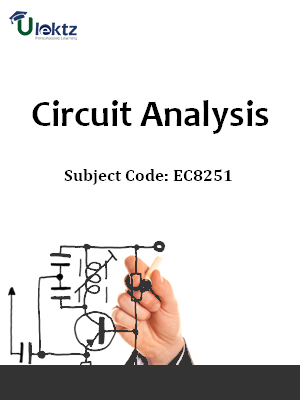

Note: Please check your Spam or Junk folder, in case you didn't receive the email with verification code.
1.1 Ohm’s law - Kirchhoff’s law
1.2 Mesh current and node voltage method of analysis for D.C and A.C. circuits
1.3 Network terminology - Graph of a network - Incidence and reduced incidence matrices - Trees
1.4 Cut sets - Fundamental cutsets - Cutset matrix - Tie sets - Link currents and tie set schedules -Twig voltages and cutset schedules
1.5 Duality and dual networks
2.1 Network theorems - Superposition theorem, Thevenin’s theorem, Norton’s theorem, Reciprocity theorem, Millman’s theorem, Maximum power transfer theorem, application of network theorems, Applications of network theorem
2.2 Network reduction: Voltage and current division
2.3 Source transformation-star delta
3.1 Resonance - Series resonance - Parallel resonance
3.2 Variation of impedance with frequency - Variation in current through and voltage across L and C with frequency
3.3 Bandwidth - Q factor - Selectivity
3.4 Self inductance - Mutual inductance - Dot rule - Coefficient of coupling - Analysis of multi winding coupled circuits
3.5 Series, parallel connection of coupled inductors - Single tuned and double tuned coupled circuits
4.1 Natural response - Forced response
4.2 Transient response of RC, RL and RLC circuits to excitation by step signal, impulse signal and exponential sources
4.3 Complete response of RC, RL and RLC circuits to sinusoidal excitation
5.1 Two port networks, Z parameters, Y parameters, Transmission(ABCD) parameters, Hybrid(H) parameters
5.2 Interconnection of two port networks, symmetrical properties of T and π networks
 No Preview is available for this book
No Preview is available for this book

 Get 100 instant uPoints on the purchase of Rs.100 or above for each order.
Get 100 instant uPoints on the purchase of Rs.100 or above for each order.
CategoriesElectronics & Communication

Format EPUB

TypeeBook